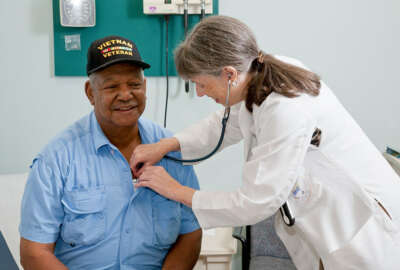

Hubbard Radio Washington DC, LLC. All rights reserved. This website is not intended for users located within the European Economic Area.
Should animals be used in medical research? The Veterans Health Administration has responded to criticism of the practice but Federal Drive with Tom Temin spoke...
Best listening experience is on Chrome, Firefox or Safari. Subscribe to Federal Drive’s daily audio interviews on Apple Podcasts or PodcastOne.
This topic can get emotional: Should animals be used in medical research? Now recently I aired an interview that was critical of the Veterans Health Administration for its use of cats in research experiments related to the bodily functions of paraplegics. VHA did submit a rebuttal statement but the agency has not responded to requests for an interview. Americans for Medical Progress is an organization that advocates in favor of the ethical use of animals in medical research. Executive Director of Paula Clifford and Communications Director Jim Newman joined Federal Drive with Tom Temin.
Interview transcript:
Tom Temin: Alright, let’s get right to this. Can animals be ethically used for research? We know they are, but is this something that has value in medical research?
Paula Clifford: Absolutely. I started out in research as a veterinary technician. And at that time, I was just doing an externship. I was a student, and I thought I would do my externship and go and spend my career working at a veterinary hospital. But during that time, I found that as a veterinary technician, I could dedicate my life to taking care of the animals that actually take care of people and other animals through research with them.
Jim Newman: And my early career experience was working at universities. I first worked at an institution in Oregon and then I worked for a cancer center. And what I learned from those experiences is that animals play a tremendously important role in developing treatments, I literally watched as cancer medications were developed, or new ways to treat patients were created through animal studies, or discovered through animal studies. And so that’s one of the reasons I remain involved in this field is that I had first hand experience seeing the importance of this kind of research.
Tom Temin: And how is this done such that the animals don’t suffer too much, in general?
Paula Clifford: Animals in research are cared for, a very large team of animal care professionals. And this is everybody from highly trained animal care technicians that do their day-to-day care. So feed, water, cleaning, and daily observations. And then you have veterinary technicians like me, who will then respond to any abnormal report. So if you have an itchy mouse, or a dog that’s not eating normally, or a monkey that’s behaving differently, that gets triaged to the vet care team. So the veterinary technician will check the animals out and then report that to the veterinarian who will come and diagnose and treat the animal.
Tom Temin: Well, let me ask you this, are there industry standards in the research community for how animals should be treated? Is there some sort of a certification program or any kind of inspection oversight that happens in facilities where animals are used in research?
Paula Clifford: Absolutely. So under the Animal Welfare Act, most animals are covered under that act. And that requires the USDA – the United States Department of Agriculture – to do at least an annual unannounced inspection to make sure that the animal care is compliant with those federal laws. But not all animals are covered under that act. But most animals are covered under the PHS policy, which needs to be followed by any institution that receives any government funding.
Tom Temin: PHS stands for ?
Paula Clifford: Public Health Service. So the majority of animals are covered under one of those two things. But there are some animals that are not and there’s another layer, which is a voluntary accreditation by AAALAC International, and that really holds institutions at even higher standards. And they follow really detailed animal care protocols in a document called the guide for laboratory animal use.
Tom Temin: Jim, anything to add?
Jim Newman: I would just add that in addition to all of those external controls, there are internal controls at every institution, so as you probably can guess, there are inspections of facilities, and those are surprise inspections, but they can’t be inspected every single day. So every institution is required to have its own system for monitoring how animals are cared for. And when you hear about something that happens, which is a rare thing that often is because the institution itself said, oh, here’s an issue we need to address. So there are actually internal controls, as well as external controls to help ensure that animals are treated well.
Tom Temin: We’re speaking with Jim Newman, he’s the communications director, and with Paula Clifford, the executive director of Americans for Medical Progress. And again, you can’t speak for what happens inside Veterans Affairs, but in your observations over the years, have the federal facilities that use animals in testing – and there are quite a number of them – generally follow these guidelines, including the federal ones?
Jim Newman: Absolutely. In fact, I was looking a little bit at the VA’s research and it stands out for many reasons. One is that 99% of the research that the VA does is in rats and mice. Now you hear a lot of talk about other animals, and that’s because the animal rights groups like to talk about that. But 99% is in, again, rats or mice, and in those very rare cases where they study other animals such as cats or dogs, there’s a good reason for that – it’s because those animals are specifically necessary for the kinds of studies that are conducted and looking at the list of achievements from the VA is pretty remarkable. They’ve been able to help veterans who receive spinal cord injuries that help them breathe, help them cough to clear their breathing channels. Bladder control is another issue that happens when you lose, you know, the ability to move your limbs. That’s something they’ve helped them with. Artificial pancreas, organ transplants – the list is 20 or 30 major items that have been accomplished through animal studies. So the VA’s research is incredibly remarkable. Anybody who would like to do some research on it should really look at their site, because what they’re doing his outstanding research that actually helps both veterans but also all Americans.
Tom Temin: And Paula, what is it that your organization does to kind of get this word out? I mean, Americans for Medical Progress could cover almost any topic.
Paula Clifford: Sure. So a lot of what we do is we actually help those working with the animals either on the animal care side or the researcher side, to help them tell their story and share with the public really what it’s like to work with animals and research, why, when and how animals are involved in research. We also do a lot of work with institutions to help them engage with the public and really share, you know, what is it about animals that make it so necessary and so important to advance biomedical progress?
Tom Temin: I once spoke to a dairy farmer in a story I did is a very young reporter very many years ago. And they had, I don’t know, 50 or 60 cows in this barn. And at the end of the cow’s life, I said, what happens when the cow gets too old? They said, well it becomes meat. I said, but don’t you kind of get attached to them? They all have names hanging on their necks. And the farmer – it was the wife of the farmer, I guess she was a farmer, too – said, ‘Well, we just consider it their final gift to us when they become steaks.’ And so not to get too touchy feely here, but people that handle animals in experimental situations, what kind of relationship do they have with the animals, do you think?
Paula Clifford: Oh, gosh, I can tell you what I know for sure. You certainly do get attached. I can share personal stories. And there’s, if you talk to anybody who works with animals in research, they also do get attached. They have names. And often they do have to be euthanized at the end of the study. Because in order to get the data from the study, you need to look at the cellular level, you need to maybe take out the heart or look at the bladder. So that’s really difficult. Any area of veterinary medicine can be heartbreaking, there’s really rewarding and happy times. And there’s really emotional and sad times. So there’s crying that happens as well, because you do get attached to the animals and the end of study does come but we know that like the dairy farmer, it is their final gift to us. And not only will they be helping the scientists with their data, but the humans that will benefit from the data. And often the advancements that happen for humans also go on to benefit our pets as well: Surgical techniques, vaccines, medicines and multiple other types of advancements.
Tom Temin: And Jim, I guess people that are involved in this kind of work are also pet owners themselves, aren’t they?
Jim Newman: That’s very true. A lot of people enter animal care, for instance, because they want to work with animals, they want to be up close with them every single day. And you know, Americans, I think the percentage of Americans that own pets and love their pets is incredible. And of course, that includes scientists and animal care technicians. And anybody who works in a research facility. People who work with animals at work, also love those animals at work and at home. And there’s some assumptions that people who work with animals in a research setting don’t like animals, that’s actually the opposite. The truth is that they love the animals they care for. And they probably go home to some of the pets that they also love just as much.
Paula Clifford: Yeah. And just to add, in some cases, when the study is complete, and the animal does not need to be euthanized, they get adopted. So I adopted a dog from research. He was on a pacemaker study, and he lived with us. I adopted him at seven and he lived with us until he – at the end of his life of 15. So there’s countless stories of researchers and animal care staff, veterinarians, veterinary technicians that adopt the animals that are able to be adopted when their study has ended.
Tom Temin: Paula Clifford is executive director of Americans for Medical Progress. Thanks so much for joining me.
Paula Clifford: It was a pleasure, thank you so much.
Tom Temin: And Jim Newman is the communications director. Jim, thank you.
Jim Newman: Thank you, sir.
Tom Temin: We’ll post this interview at FederalNewsNetwork.com/FederalDrive. Hear the Federal Drive on demand. Subscribe at Apple Podcasts or Podcastone.
Copyright © 2024 Federal News Network. All rights reserved. This website is not intended for users located within the European Economic Area.
Tom Temin is host of the Federal Drive and has been providing insight on federal technology and management issues for more than 30 years.
Follow @tteminWFED


